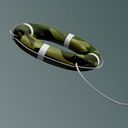Russian atrocities fuel new breakthroughs in Ukraine military aid

The defeat of Russian forces near Kyiv — and the trail of atrocities they left behind — have fueled a Western willingness to provide Ukraine with military aid once thought too provocative and cumbersome for a war Russia was expected to win in weeks.
Why it matters: Fears of angering a nuclear-armed Vladimir Putin or undermining peace talks with the Russian president have faded. Most NATO allies are now giving Ukraine whatever it needs to prevail in Act Two: a bloody, protracted battle expected in the eastern Donbas region.
- The guardrails against triggering World War III have largely fallen — short of providing the air and ground forces President Biden has pledged not to send.
- In military parlance, it's called "mission creep."
The big picture: The Biden administration was careful early in the conflict to differentiate between what it called "offensive" and "defensive" weapons, fearful of becoming a "co-combatant" under international law.
- On Sunday, national security advisor Jake Sullivan suggested that framework no longer applied given the "nature of the battle" and "war crimes" committed by Russian forces.
- "[W]e have gotten to a place in the United States, and across many members of the NATO alliance, where the key question is, 'What does Ukraine need, and how can we provide it to them?'" Sullivan said on NBC's "Meet the Press."
- The Washington Post reported Tuesday the administration is looking at an additional $750 million in aid that includes Mi-17 helicopters the Ukrainians could easily fly.
Flashback: During the first week of the invasion, neither the White House, State Department nor Pentagon would go on the record to confirm the U.S. was sending anti-aircraft Stinger missiles to Ukraine.
- Today, Western-supplied Stingers are the bread-and-butter of the Ukrainian resistance — and among the less controversial weapons on a lengthy fact sheet of military assistance proudly blasted out by the Pentagon press team last week.
- It detailed all U.S. military assistance, down to 50 million bullets, as Axios reported Thursday.
There also was a debate during the first weeks of the war about what types of intelligence the U.S. should share with Ukraine, after Rep. Adam Smith (D-Wash.), chair of the House Armed Services Committee, said in early March the U.S. was not providing Ukraine with "real-time targeting" intelligence.
- During a hearing last week, Defense Secretary Lloyd Austin said for the first time the Pentagon was sharing intelligence aimed at helping Ukraine conduct offensive operations in the Russian-occupied Donbas.
- When Republican senators complained Monday that wasn't enough, a U.S. official publicly retorted: "The U.S. is providing detailed, timely intelligence to the Ukrainians on a range of fronts."
The shift isn't limited to the U.S.
The German government was mocked for sending 5,000 helmets to Ukraine in February, but is now considering joining NATO allies in providing "heavy weaponry" in anticipation of the next phase of war.
- The Czech Republic became the first NATO country to send tanks to Ukraine last week, while Slovakia fulfilled a longtime request from Ukrainian President Volodymyr Zelensky by transferring an S-300 air defense system.
- Slovakia also revived a proposal this week to send Soviet-era MiG-29 fighter jets to Ukraine.
Between the lines: Even the fact that Ukrainian forces may need training to use new weapons systems isn't deterring their delivery.
- Instruction in using more sophisticated systems, such as Switchblade drones supplied by the U.S., is "not prohibitive to our decision-making," a senior U.S. defense official told reporters Tuesday.